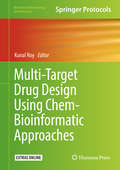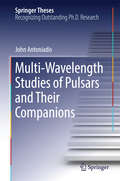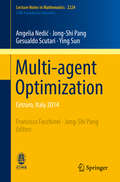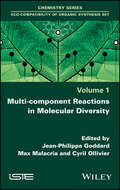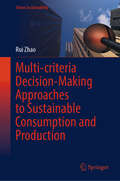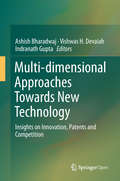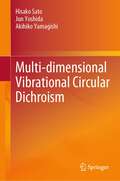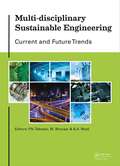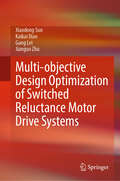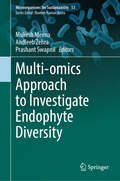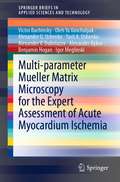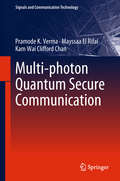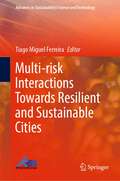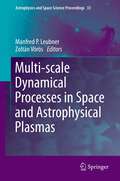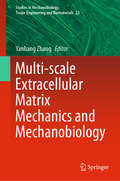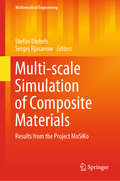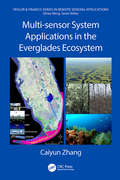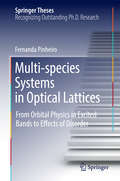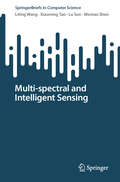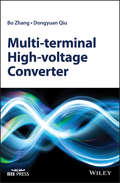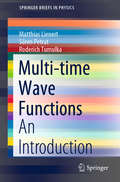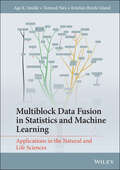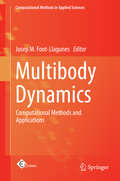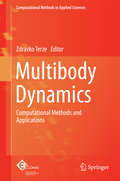- Table View
- List View
Multi-Target Drug Design Using Chem-Bioinformatic Approaches (Methods in Pharmacology and Toxicology)
by Kunal Roy<p>This detailed book showcases recent advances in computational design of multi-target drug candidates involving various ligand and structure-based strategies. Different chem-bioinformatic modeling strategies that can be applied for design of multi-target drugs as well as important databases and web servers in connection with multi-target drug design are also featured in this collection. Written for the Methods in Pharmacology and Toxicology series, chapters include the kind of key implementation advice that will aid researchers greatly in their laboratory pursuits. <p>Authoritative and practical, Multi-Target Drug Design Using Chem-Bioinformatic Approaches seeks to aid all scientists working in the field of drug discovery research.</p>
Multi-Wavelength Studies of Pulsars and Their Companions
by John AntoniadisThe focus of his prize-winning thesis is on observations and modeling of binary millisecond pulsars. But in addition, John Antoniadis covers a wide range of observational measurements of binary compact stars systems and tests of General Relativity, like indirect measurements of gravitational wave emission and posing the most stringent constraints on Scalar-Tensor gravity theories. Among others, he presents a system that hosts the most massive neutron star known to date, which has important ramifications for strong-field gravity and nuclear physics. This impressive work was awarded the Otto-Hahn Medal of the Max-Planck Society and the Best PhD in Gravity, Particle and Atomic physics award by the German Physics Society (DPG).
Multi-agent Optimization: Cetraro, Italy 2014 (Lecture Notes in Mathematics #2224)
by Angelia Nedić Jong-Shi Pang Gesualdo Scutari Ying Sun Francisco FacchineiThis book contains three well-written research tutorials that inform the graduate reader about the forefront of current research in multi-agent optimization. These tutorials cover topics that have not yet found their way in standard books and offer the reader the unique opportunity to be guided by major researchers in the respective fields. Multi-agent optimization, lying at the intersection of classical optimization, game theory, and variational inequality theory, is at the forefront of modern optimization and has recently undergone a dramatic development. It seems timely to provide an overview that describes in detail ongoing research and important trends. This book concentrates on Distributed Optimization over Networks; Differential Variational Inequalities; and Advanced Decomposition Algorithms for Multi-agent Systems. This book will appeal to both mathematicians and mathematically oriented engineers and will be the source of inspiration for PhD students and researchers.
Multi-component Reactions in Molecular Diversity
by Jean-Philippe Goddard Max Malacria Cyril OllivierWhile very useful for studying syntheses of molecular diversity, multi-component reactions also offer rapid access to a variety of complex molecules that are relevant for biological applications. Multi-component Reactions in Molecular Diversity analyzes these reactions, whether they are realized by organometallic, ionic or even radical processes. It highlights popular methods based on monotype reactions (cascade, tandem, domino) and their efficiency and academic industrial domain are illustrated. This book also investigates the most efficient ways to prepare complex molecules. Multi-component reactions are in tune with the concepts of atom and steps economy, which are of prior importance in all the reported processes ? from the laboratory to the pilot scale. The essential criteria for green chemistry are also examined in the book in detail.
Multi-criteria Decision-Making Approaches to Sustainable Consumption and Production (Urban Sustainability)
by Rui ZhaoThis book applies multi-criteria decision-making (MCDM) approaches to facilitate sustainable consumption and production. Sustainable consumption and production not only focuses on the economic prosperity but also pays great attention to environmental protection and social justice, in order to promote sustainable development. In such context, most ‘material’ can be deemed as ‘hazardous’ at any stage of their lifecycle, i.e., from extraction to final disposal, because of its quantity, concentration, or physical, chemical, or infectious characteristics, may cause, or pose a substantial or potential hazard to human health or the environment. Through the application of system theory, game theory, optimization theory, as well as various computational approaches, this book helps engineers/ policy makers to identify solutions or mitigation strategies to reduce environmental impact associated with consumption and production. It is essential reading for students, researchers, policy makers as well as those with a wider interest in environmental science and sustainable development.
Multi-dimensional Approaches Towards New Technology: Insights on Innovation, Patents and Competition
by Indranath Gupta Ashish Bharadwaj Vishwas H. DevaiahThis open access edited book captures the complexities and conflicts arising at the interface of intellectual property rights (IPR) and competition law. To do so, it discusses four specific themes: (a) policies governing functioning of standard setting organizations (SSOs), transparency and incentivising future innovation; (b) issue of royalties for standard essential patents (SEPs) and related disputes; (c) due process principles, procedural fairness and best practices in competition law; and (d) coherence of patent policies and consonance with competition law to support innovation in new technologies. Many countries have formulated policies and re-oriented their economies to foster technological innovation as it is seen as a major source of economic growth. At the same time, there have been tensions between patent laws and competition laws, despite the fact that both are intended to enhance consumer welfare. In this regard, licensing of SEPs has been debated extensively, although in most instances, innovators and implementers successfully negotiate licensing of SEPs. However, there have been instances where disagreements on royalty base and royalty rates, terms of licensing, bundling of patents in licenses, pooling of licenses have arisen, and this has resulted in a surge of litigation in various jurisdictions and also drawn the attention of competition/anti-trust regulators. Further, a lingering lack of consensus among scholars, industry experts and regulators regarding solutions and techniques that are apposite in these matters across jurisdictions has added to the confusion. This book looks at the processes adopted by the competition/anti-trust regulators to apply the principles of due process and procedural fairness in investigating abuse of dominance cases against innovators.
Multi-dimensional Vibrational Circular Dichroism
by Akihiko Yamagishi Hisako Sato Jun YoshidaThis book provides the reader with the latest research on vibrational circular dichroism (VCD) spectroscopy including its useful features and applications to many fields. The book starts from an unresolved question in gel chemistry of how component molecules are organized in the flexible fibrils of gels. VCD spectroscopy was successful in giving a clear answer to this mystery. The book also describes a key aspect of this technique lay in the fact that VCD signals were remarkably enhanced when chiral molecules formed a stereoregular molecular array over a few hundred nanometers. VCD spectroscopy was also applied to other topics involving chiral molecules such as the chiral discrimination mechanism in heterogeneous asymmetric catalysis and the build-up of supramolecular chirality in molecular crystals. Furthermore, the book covers the recent instrument developments leading to multi-dimensional VCD measurements with the coordinates of wavenumber, space and time. This progress has opened up new biological and medical applications such as the heterogenous distributions of protein domains in insect wings and the quality control of chiral drugs. The last part of the book presents the possibility of medical diagnosis of Alzheimer’s disease through multi-dimensional VCD analyses. This book appeals not only to researchers and students who study spectroscopy but also to ones in catalysis, biology and medicine as users of the VCD methods.
Multi-disciplinary Sustainable Engineering: Proceedings of the 5th Nirma University International Conference on Engineering, Ahmedabad, India, November 26-28, 2015
by M. Bhavsar B. A. Modi P. N. TekwaniThe Nirma University International Conference on Engineering NUiCONE is a flagship event of the Institute of Technology, Nirma University, Ahmedabad. NUiCONE-2015 is focussed on events/themes in the current trends in Engineering and its research issues. Practicing engineers, technologists and technopreneurs from the industry&nbs
Multi-objective Design Optimization of Switched Reluctance Motor Drive Systems
by Gang Lei Jianguo Zhu Xiaodong Sun Kaikai DiaoThis book presents the design optimization method for switched reluctance motors (SRMs) and drive systems. It covers an in-depth literature review on the status and potential trend of design optimization techniques for SRMs, including design theory, modeling methods, topologies, control methods, and techniques for optimization efficiency and effects. Readers will discover new design methods based on the specific nonlinear characteristics of SRMs, and multi-objective optimization methods for the design of high-quality switched reluctance drive systems without or with the consideration of uncertainties, i.e., the deterministic and robust approaches. Multi-mode design optimization method regarding SRMs is investigated and some examples are presented. In addition, some essential trends in design optimization development are presented and highlighted as future perspectives. This book benefits students, researchers, engineers, and companies in the field of electrical drive design and manufacturing. The focuses of this book are different from those of the published books. The advanced optimization methods including deterministic optimization, robust optimization, and system-level optimization are not discussed in these books. Besides, new design method based on the nonlinear characteristic and multi-mode optimization combined with specific application will be introduced to the design of high-performance of switched reluctance machines.
Multi-objective Management in Freight Logistics: Increasing Capacity, Service Level, Sustainability, and Safety with Optimization Algorithms
by Massimiliano Caramia Paolo Dell’OlmoThe second edition of Multi-Objective Management in Freight Logistics builds upon the first, providing a detailed study of freight transportation systems, with a specific focus on multi-objective modelling. It offers decision-makers methods and tools for implementing multi-objective optimisation models in logistics. The second edition also includes brand-new chapters on green supply chain and hybrid fleet management problems.After presenting the general framework and multi-objective optimization, the book analyses green logistic focusing on two main aspects: green corridors and network design; next, it studies logistic issues in a maritime terminal and route planning in the context of hazardous material transportation. Finally, heterogeneous fleets distribution and coordination models are discussed.The book presents problems providing the mathematics, algorithms, implementations, and the related experiments for each problem. It offers a valuable resource for postgraduate students and researchers in transportation, logistics and operations, as well as practitioners working in service systems.
Multi-omics Approach to Investigate Endophyte Diversity (Microorganisms for Sustainability #53)
by Mukesh Meena Andleeb Zehra Prashant SwapnilThis book deals with the multi-omics approaches to investigate the diversity of endophytes and their interaction with plants in diversified ecological systems. This book helps to integrate the omics approaches to understand the detailed structure of plant-microbial interactions and the mechanism of plant-microbe responses under various environmental conditions. It discusses different omics technologies including metabolomics, genomics, metagenomics, and volatilomics in plant disease. It also incorporates parts of the ecology and genetics of fungal endophytes, particularly how they identify with the host genome and the synthesis of significant and beneficial products. The proteomic trends of fungal endophytes is scrutinized, offering valuable insights for biotechnological applications. The book further explores the impact of fungal endophytes on nutrient cycling within the rhizosphere microbiome, providing a holistic view of their influence on nutrient dynamics and related microbialcommunities. This book serves as a reference resource for researchers and practitioners working towards advancements in agriculture, environmental science, and biotechnology.
Multi-parameter Mueller Matrix Microscopy for the Expert Assessment of Acute Myocardium Ischemia (SpringerBriefs in Applied Sciences and Technology)
by Igor Meglinski Victor Bachinsky Alexander Bykov Benjamin Hogan Oleh Ya Vanchulyak Alexander G. Ushenko Yurii A. Ushenko Alexander V. DubolazovThis book provides an essential overview of the basic principles of imaging modalities, accompanied by examples of their applications in modern clinical and associated pre-clinical studies. The monograph is based on the original results of investigation of the efficiency use of laser light and Mueller-matrix polarimetry approach for assessment of myocardial tissues towards confirmation the cause of death. A morphological analysis of necrotic changes in the myocardial tissue of patients that died due to heart attack, coronary heart disease and acute coronary insufficiency was carried out and the data and histological sections of the myocardium inspected utilizing Mueller-matrix mapping of tissue samples with polarized light. A unified optical model of polycrystalline structure of the myocardium is proposed, and the principles and regulations of Mueller-matrix description of its polarization manifestations are explored and developed. The book also provides a statistical and scale-selective wavelet analysis of polarization and Mueller-matrix maps. Finally, the key forensic medical criteria for the differential diagnosis of the cause of death due to necrotic and pathological changes in the morphological structure of the myocardium have been established
Multi-photon Quantum Secure Communication (Signals and Communication Technology)
by Pramode K. Verma Mayssaa El Rifai Kam Wai ChanThis book explores alternative ways of accomplishing secure information transfer with incoherent multi-photon pulses in contrast to conventional Quantum Key Distribution techniques. Most of the techniques presented in this book do not need conventional encryption. Furthermore, the book presents a technique whereby any symmetric key can be securely transferred using the polarization channel of an optical fiber for conventional data encryption. The work presented in this book has largely been practically realized, albeit in a laboratory environment, to offer proof of concept rather than building a rugged instrument that can withstand the rigors of a commercial environment.
Multi-risk Interactions Towards Resilient and Sustainable Cities (Advances in Sustainability Science and Technology)
by Tiago Miguel FerreiraFor years, researchers have studied the risks of individual natural hazards in urban areas. However, the impact of multiple hazards has not yet received widespread attention in research and urban management practice, which is a significant gap in the current climate change context. This book aims to contribute to filling that gap by examining the process of identifying, assessing, and managing multi-hazard risks in urban areas. From identifying and assessing the vulnerability of the elements exposed to the impact of natural hazards, including earthquakes, floods, fires, and landslides, this book covers all the critical stages of multi-hazard risk assessment and management in a climate change context. The concepts and approaches discussed in the book are applied to the Lisbon Metropolitan Area, a dynamic and thriving metropolis, allowing readers to see those theories applied in a real setting. In addition to providing a solid theoretical foundation, this book offers practical guidelines for conducting risk assessment at the metropolitan scale, which makes it a valuable resource for researchers, practitioners, and decision-makers interested in understanding and managing multi-hazard risks in urban areas.
Multi-scale Dynamical Processes in Space and Astrophysical Plasmas
by Manfred P. Leubner Zoltán VörösMagnetized plasmas in the universe exhibit complex dynamical behavior over a huge range of scales. The fundamental mechanisms of energy transport, redistribution and conversion occur at multiple scales. The driving mechanisms often include energy accumulation, free-energy-excited relaxation processes, dissipation and self-organization. The plasma processes associated with energy conversion, transport and self-organization, such as magnetic reconnection, instabilities, linear and nonlinear waves, wave-particle interactions, dynamo processes, turbulence, heating, diffusion and convection represent fundamental physical effects. They demonstrate similar dynamical behavior in near-Earth space, on the Sun, in the heliosphere and in astrophysical environments. 'Multi-scale Dynamical Processes in Space and Astrophysical Plasmas' presents the proceedings of the International Astrophysics Forum Alpbach 2011. The contributions discuss the latest advances in the exploration of dynamical behavior in space plasmas environments, including comprehensive approaches to theoretical, experimental and numerical aspects. The book will appeal to researchers and students in the fields of physics, space and astrophysics, solar physics, geophysics and planetary science.
Multi-scale Extracellular Matrix Mechanics and Mechanobiology (Studies in Mechanobiology, Tissue Engineering and Biomaterials #23)
by Yanhang ZhangThis book describes the current state of knowledge in the field of multi-scale ECM mechanics and mechanobiology with a focus on experimental and modelling studies in biomechanical characterization, advanced optical microscopy and imaging, as well as computational modeling. This book also discusses the scale dependency of ECM mechanics, translation of mechanical forces from tissue to cellular level, and advances and challenges in improving our understanding of cellular mechanotransduction in the context of living tissues and organisms.
Multi-scale Simulation of Composite Materials: Results from the Project MuSiKo (Mathematical Engineering)
by Stefan Diebels Sergej RjasanowDue to their high stiffness and strength and their good processing properties short fibre reinforced thermoplastics are well-established construction materials.Up to now, simulation of engineering parts consisting of short fibre reinforced thermoplastics has often been based on macroscopic phenomenological models, but deformations, damage and failure of composite materials strongly depend on their microstructure. The typical modes of failure of short fibre thermoplastics enriched with glass fibres are matrix failure, rupture of fibres and delamination, and pure macroscopic consideration is not sufficient to predict those effects. The typical predictive phenomenological models are complex and only available for very special failures. A quantitative prediction on how failure will change depending on the content and orientation of the fibres is generally not possible, and the direct involvement of the above effects in a numerical simulation requires multi-scale modelling.One the one hand, this makes it possible to take into account the properties of the matrix material and the fibre material, the microstructure of the composite in terms of fibre content, fibre orientation and shape as well as the properties of the interface between fibres and matrix. On the other hand, the multi-scale approach links these local properties to the global behaviour and forms the basis for the dimensioning and design of engineering components. Furthermore, multi-scale numerical simulations are required to allow efficient solution of the models when investigating three-dimensional problems of dimensioning engineering parts.Bringing together mathematical modelling, materials mechanics, numerical methods and experimental engineering, this book provides a unique overview of multi-scale modelling approaches, multi-scale simulations and experimental investigations of short fibre reinforced thermoplastics. The first chapters focus on two principal subjects: the mathematical and mechanical models governing composite properties and damage description. The subsequent chapters present numerical algorithms based on the Finite Element Method and the Boundary Element Method, both of which make explicit use of the composite’s microstructure. Further, the results of the numerical simulations are shown and compared to experimental results.Lastly, the book investigates deformation and failure of composite materials experimentally, explaining the applied methods and presenting the results for different volume fractions of fibres.This book is a valuable resource for applied mathematics, theoretical and experimental mechanical engineers as well as engineers in industry dealing with modelling and simulation of short fibre reinforced composites.
Multi-sensor System Applications in the Everglades Ecosystem (Remote Sensing Applications Series)
by Caiyun ZhangThis book explores the applicability of multiple remote sensors to acquire information relevant to restoration and conservation efforts in wetlands using data collected from airborne and space multispectral/hyperspectral sensors, light detection and ranging (LiDAR), Unmanned Aircraft Systems (UAS), and a hand-held spectroradiometer. This book also examines digital data processing techniques such as object-based image analysis, machine learning, texture analysis, and data fusion. After an introduction to the Everglades and to remote sensing, the book is divided into four parts based on the sensor systems used. There are chapters on vegetation mapping, biomass and water quality modeling, applications of hyperspectral data for plant stress analysis and coral reef mapping, studies of airborne LiDAR data for coastal vulnerability analysis and DEM improvement, as well as chapters that explore a fusion of multiple sensors for different datasets. <p><p>Features <li>Introduces concepts, theories, and advanced processing techniques <li>A complete introduction of machine learning, object-based image analysis, data fusion, and ensemble analysis techniques in processing data from multiple remote sensors <li>Explains how multiple remote sensing systems are applied in the wetland ecosystems of Florida <li>The author had been teaching and using both systems and her research is widely recognized <p><p>Multi-sensor System Applications in the Everglades Ecosystems provides a comprehensive application of remote sensing techniques in the Florida Everglades and its coastal ecosystems. It will prove an invaluable resource for the restoration and conservation of the Florida Everglades and beyond, for global wetlands in general. Any professional, scientist, engineer, or student working with remote sensing and wetland ecosystems will reap enormous benefits from this book.
Multi-species Systems in Optical Lattices
by Fernanda PinheiroThis highly interdisciplinary thesis covers a wide range of topics relating to the interface of cold atoms, quantum simulation, quantum magnetism and disorder. With a self-contained presentation, it provides a broad overview of the rapidly evolving area of cold atoms and is of interest to both undergraduates and researchers working in the field. Starting with a general introduction to the physics of cold atoms and optical lattices, it extends the theory to that of systems with different multispecies atoms. It advances the theory of many-body quantum systems in excited bands (of optical lattices) through an extensive study of the properties of both the mean-field and strongly correlated regimes. Particular emphasis is given to the context of quantum simulation, where as shown here, the orbital degree of freedom in excited bands allows the study of exotic models of magnetism not easily achievable with the previous alternative systems. In addition, it proposes a new model Hamiltonian that serves as a quantum simulator of various disordered systems in different symmetry classes that can easily be reproduced experimentally. This is of great interest, especially for the study of disorder in 2D quantum systems.
Multi-spectral and Intelligent Sensing (SpringerBriefs in Computer Science)
by Xiaoming Tao Lu Sun Liting Wang Wentao ShenThis book provides a concise overview of intelligent technologies for vision and sensing, with a particular focus on their applications in various multispectral configurations, including safety monitoring in rural areas. Within the realm of intelligent perception and contemporary healthcare, the book emphasizes the real-time monitoring, analysis, and prediction of vital signals using biomedical optical sensors. This approach aims to offer more adaptable and personalized services within the medical health management domain. Furthermore, the book delves into the comprehensive comprehension of physiological signals and additional data sources, such as environmental and motion data. The goal is to enhance the breadth and depth of data analysis, providing more integrated support for the life and health sector. Additionally, the book explores the implementation of edge intelligence algorithms at the sensor level to enable real-time analysis, enhancing the efficiency of sensor data processing and utilization. Detailed explanations of the configuration and deployment of an active vision camera system featuring an integrated edge algorithm are provided to elucidate the coordination and communication mechanisms of edge intelligence technology across multiple edge devices. A specific application case is then presented—the universal camera jamming system—which underscores the benefits of intelligent sensing fusion for tasks such as attitude and position recognition, as well as self-feedback excitation jamming. The book underscores the pervasive and seamless integration of smart sensing in both current and future lifestyles, spanning from active vision cameras to diverse applications across multiple spectrums. Its insights are poised to stimulate innovation and application within the realms of smart vision and sensing, including a comprehensive analysis of future healthcare paradigms.
Multi-terminal High-voltage Converter
by Bo Zhang Dongyuan QiuAn all-in-one guide to high-voltage, multi-terminal converters, this book brings together the state of the art and cutting-edge techniques in the various stages of designing and constructing a high-voltage converter. The book includes 9 chapters, and can be classified into three aspects. First, all existing high-voltage converters are introduced, including the conventional two-level converter, and the multi-level converters, such as the modular multi-level converter (MMC). Second, different kinds of multi-terminal high-voltage converters are presented in detail, including the topology, operation principle, control scheme and simulation verification. Third, some common issues of the proposed multi-terminal high-voltage converters are discussed, and different industrial applications of the proposed multi-terminal high-voltage converters are provided. Systematically proposes, for the first time, the design methodology for high-voltage converters in use of MTDC grids; also applicable to constructing novel power electronics converters, and driving the development of HVDC, which is one of the most important technology areas Presents the latest research on multi-terminal high-voltage converters and its application in MTDC transmission systems and other industrially important applications Offers an overview of existing technology and future trends of the high-voltage converter, with extensive discussion and analysis of different types of high-voltage converters and relevant control techniques (including DC-AC, AC-DC, DC-DC, and AC-AC converters) Provides readers with sufficient context to delve into the more specialized topics covered in the book Featuring a series of novel multi-terminal high-voltage converters proposed and patented by the authors, Multi-terminal High Voltage Converters is written for researchers, engineers, and advanced students specializing in power electronics, power system engineering and electrical engineering.
Multi-time Wave Functions: An Introduction (SpringerBriefs in Physics)
by Matthias Lienert Sören Petrat Roderich TumulkaThe natural generalization of the quantum-mechanical N-particle wave function to relativistic space-time is a function of N space-time points, and thus of N time variables. This book, based on a collection of lectures given at a spring school in Tübingen in 2019, provides an accessible and concise introduction to the recent development of the theory of multi-time wave functions, their use in quantum field theory, their relation to detection probabilities, and the mathematical question of consistency of their time evolution equations. The book is intended for advanced students and researchers with an interest in relativity and quantum physics.
Multiblock Data Fusion in Statistics and Machine Learning: Applications in the Natural and Life Sciences
by Tormod Næs Age K. Smilde Kristian Hovde LilandMultiblock Data Fusion in Statistics and Machine Learning Explore the advantages and shortcomings of various forms of multiblock analysis, and the relationships between them, with this expert guide Arising out of fusion problems that exist in a variety of fields in the natural and life sciences, the methods available to fuse multiple data sets have expanded dramatically in recent years. Older methods, rooted in psychometrics and chemometrics, also exist. Multiblock Data Fusion in Statistics and Machine Learning: Applications in the Natural and Life Sciences is a detailed overview of all relevant multiblock data analysis methods for fusing multiple data sets. It focuses on methods based on components and latent variables, including both well-known and lesser-known methods with potential applications in different types of problems. Many of the included methods are illustrated by practical examples and are accompanied by a freely available R-package. The distinguished authors have created an accessible and useful guide to help readers fuse data, develop new data fusion models, discover how the involved algorithms and models work, and understand the advantages and shortcomings of various approaches. This book includes: A thorough introduction to the different options available for the fusion of multiple data sets, including methods originating in psychometrics and chemometrics Practical discussions of well-known and lesser-known methods with applications in a wide variety of data problems Included, functional R-code for the application of many of the discussed methods Perfect for graduate students studying data analysis in the context of the natural and life sciences, including bioinformatics, sensometrics, and chemometrics, Multiblock Data Fusion in Statistics and Machine Learning: Applications in the Natural and Life Sciences is also an indispensable resource for developers and users of the results of multiblock methods.
Multibody Dynamics
by Josep M. Font-LlagunesThis book includes selected papers from the ECCOMAS Thematic Conference on Multibody Dynamics, that took place in Barcelona, Spain, from June 29 to July 2, 2015. By having its origin in analytical and continuum mechanics, as well as in computer science and applied mathematics, multibody dynamics provides a basis for analysis and virtual prototyping of innovative applications in many fields of contemporary engineering. With the utilization of computational models and algorithms that classically belonged to different fields of applied science, multibody dynamics delivers reliable simulation platforms for diverse highly-developed industrial products such as vehicle and railway systems, aeronautical and space vehicles, robotic manipulators, smart structures, biomechanical systems, and nanotechnologies.
Multibody Dynamics
by Zdravko TerzeBy having its origin in analytical and continuum mechanics, as well as in computer science and applied mathematics, multibody dynamics provides a basis for analysis and virtual prototyping of innovative applications in many fields of contemporary engineering. With the utilization of computational models and algorithms that classically belonged to different fields of applied science, multibody dynamics delivers reliable simulation platforms for diverse highly-developed industrial products such as vehicle and railway systems, aeronautical and space vehicles, robotic manipulators, smart structures, biomechanical applications and nano-technologies. The chapters of this volume are based on the revised and extended versions of the selected scientific papers from amongst 255 original contributions that have been accepted to be presented within the program of the distinguished international ECCOMAS conference. It reflects state-of-the-art in the advances of multibody dynamics, providing excellent insight in the recent scientific developments in this prominent field of computational mechanics and contemporary engineering.
